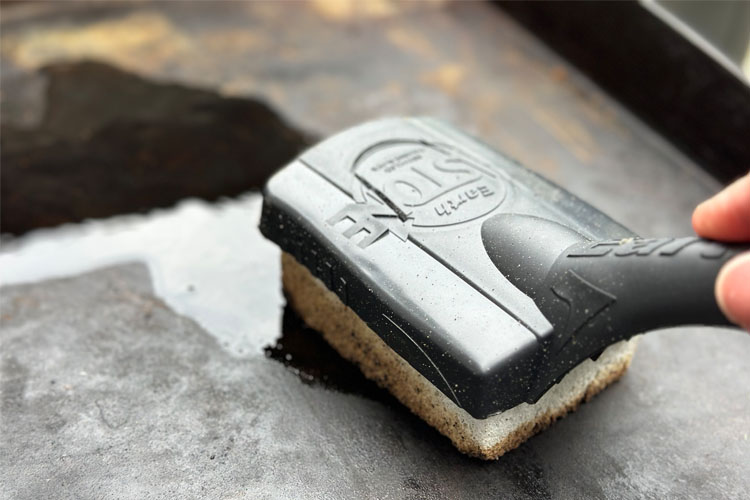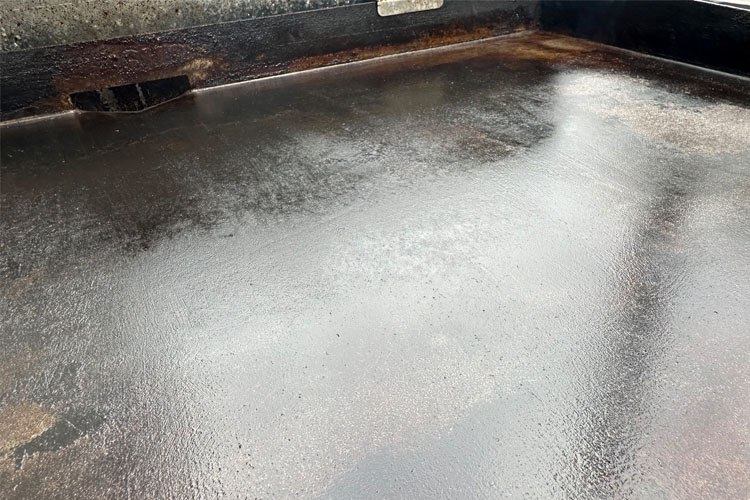How to Restore a Rusty Griddle

Are you guilty of griddle neglect?
With some elbow grease, you can have your griddle looking new again.
I will show you how to get your rusty griddle looking like new again, plus share some times on how to maintain your griddle to prevent it from rusting again.
How to Restore a Rusty Griddle
To restore a griddle that has accumulated a layer of rust, you will need a few simple tools:
- High-heat cooking oil
- Metal scraper or spatula
- Grill stone (or sandpaper)
- Paper towels
Check out our list of essential griddle accessories for all the gear we recommend.
1. Fire up the griddle
Turn your griddle on medium-high heat and let it preheat for about 15 minutes. The heat will help loosen any rust, food, or debris on your cooking surface.
Once your grill has preheated, lower the temperature knobs to the lowest heat setting.
2. Scrape your griddle
Using a metal scraper or spatula, you want to scrape off as much rust and debris on your cooktop as possible.
You won’t be able to remove everything, but trying to get as much off with the scraper as possible is essential to give you the smoothest surface to start working on.

As you scrape the griddle, you can push the rust and debris that scrapes off into the grease reservoir.
3. Clean the griddle with a grill stone (or sandpaper)
This part of the process is where the elbow grease comes into play. You need to use a lot of force when scraping your griddle, as you want to ensure that you remove any rust or corrosion on the cooktop.


Many griddle companies offer a grill stone you can purchase, but you can also grab a sheet of 120-grit sandpaper from your local hardware store.
Add a bit of cooking oil to the surface of your griddle and scrub the entire surface in a circular motion until you have removed all of the rust and debris.


4. Clean the griddle with a cloth (or paper towel)
Add a few more drops of oil to the surface of your griddle and clean it one more time with a cloth or paper towel.


The goal is to remove any remaining rust or debris from the surface.

Repeat this process as many times as necessary until your cloth or paper towel is almost completely clean after rubbing down the surface.
5. Season your griddle
After you’ve thoroughly cleaned your griddle, you want to perform a complete seasoning as outlined above.


Seasoning your griddle will create a protective layer that will prevent your griddle from rusting again too rapidly.


How to prevent future rusting
Once you’ve fully restored your griddle, you want to make sure that you don’t have to repeat the process again.
Here are some tips to help avoid rust in the future:
- Rub down your entire cooking surface after every time you cook. Simply add a few tablespoons of cooking oil to the surface of your griddle and rub it down with a paper towel until the entire griddle has a light layer of oil on it.
- Cover your griddle with a canvas cover. When you aren’t cooking on your griddle, you want to keep it covered as much as possible. A heavy-duty cover will protect your griddle from the elements and help to keep out excess moisture.
- Store your griddle in a dry place, if possible. This is not always possible, as many people store griddles in their backyard, but if you have the room, it’s best to store the griddle in your garage or under some type of permanent covering.
What causes a griddle to rust?
Rust is the reddish-orange substance that accumulates on your cooking surface due to the iron in the griddle reacting with oxygen and water in the air.
If you live in a more humid environment, rust will be more of a problem.
If left untreated, the rust will give way to the corrosion of your cooktop and can become irreversible.
The number one cause of rust on a griddle is moisture. Keeping your griddle clean and dry is important, so I recommend storing it with the lid on and purchasing a cover to help protect it from the elements.
Another thing that will cause your griddle to rust is cooking food with high acidity levels, such as citrus and tomato-based sauces. The acidity of the food will react with the iron in the griddle and cause the seasoning layer to corrode rapidly.







